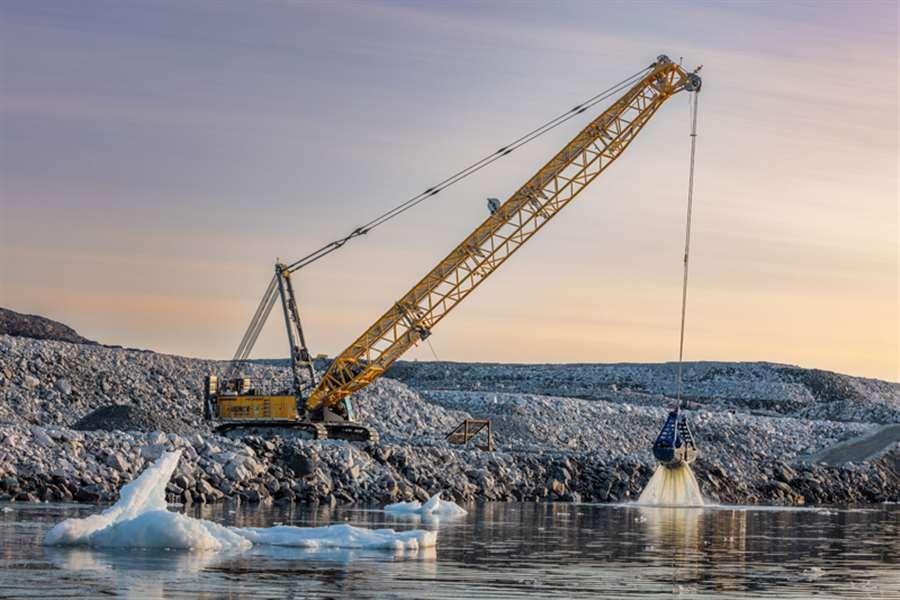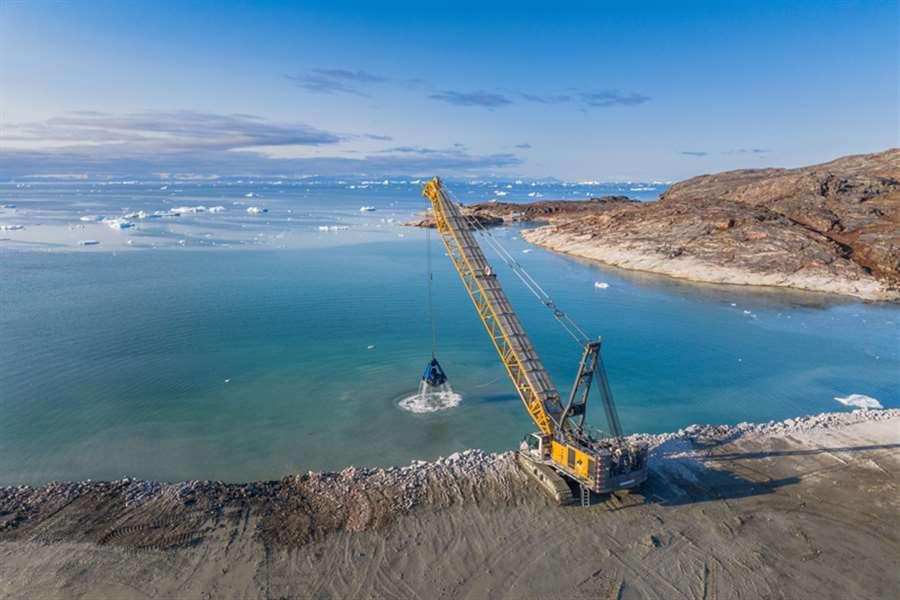R.E.News International-Liebherr crawler crane takes charge of dredging in Arctic airport build
 11/04/24-FR-English-NL-footer
11/04/24-FR-English-NL-footer
Une grue sur chenilles Liebherr prend en charge le dragage dans la construction de l'aéroport de l'Arctique

 Munck Civil Engineering is using a Liebherr HS8200 duty cycle crawler crane to dredge the seabed in Ilulissat, Greenland, ahead of the construction of a new airport (Image courtesy of Liebherr)-Munck Civil Engineering is using a Liebherr HS8200 duty cycle crawler crane to dredge the seabed in Ilulissat, Greenland, ahead of the construction of a new airport (Image courtesy of Liebherr)
Munck Civil Engineering is using a Liebherr HS8200 duty cycle crawler crane to dredge the seabed in Ilulissat, Greenland, ahead of the construction of a new airport (Image courtesy of Liebherr)-Munck Civil Engineering is using a Liebherr HS8200 duty cycle crawler crane to dredge the seabed in Ilulissat, Greenland, ahead of the construction of a new airport (Image courtesy of Liebherr)
L'entrepreneur danois Munck Civil Engineering réalise des travaux de dragage en vue de la construction de deux nouveaux aéroports au Groenland, avec l'aide d'une grue sur chenilles Liebherr.
Les nouveaux aéroports seront construits dans les villes côtières d'Ilulissat et Nuuk, à l'ouest du Groenland. Ils permettront à des avions plus gros de voler dans la région directement depuis le continent européen ou américain. Actuellement, seuls les avions à hélices peuvent y atterrir.
La nouvelle piste d'atterrissage d'Ilulissat se trouvant partiellement dans la mer, une épaisse couche de sédiments argileux doit être retirée du fond marin avant de pouvoir être remblayée.
Pour y parvenir, Munck, l'entrepreneur principal des deux projets, utilise la grue sur chenilles à cycle de service HS8200 de 200 t de Liebherr pour les travaux de dragage.
Équipée d'une flèche de 35 m de long et d'une benne preneuse d'une capacité de 3,5 mètres cubes (m3), la grue est capable d'enlever jusqu'à 1 000 m3 de matériaux excavés en une journée. Il fonctionne six jours par semaine en équipes de 10 heures.
La machine est également équipée du « Dredging Assistant » de Liebherr, qui indique à l'opérateur la position et le niveau de remplissage de la benne, le nombre et la durée des cycles de travail ou les performances de manutention en temps réel.
Pendant ce temps, Munck Civil Engineering trouvera dans ses limites tout le matériel rocheux utilisé pour le projet.
« Au total, nous devons forer et dynamiter environ 5,5 millions de mètres cubes de roche. Nous le transportons ensuite vers la section de construction afin de pouvoir ensuite construire une piste de 2 kilomètres de long », a déclaré le directeur de la construction Kevin van den Bos.
La grue est fournie avec l'ensemble froid Liebherr pour lui permettre de fonctionner pendant l'été arctique, lorsque la température moyenne est de 8 °C. Mais avec des températures hivernales descendant jusqu'à -35°C, le temps presse pour terminer les travaux avant le changement de saison. "Il est très important pour nous de terminer les travaux de dragage avant que la glace ne se propage dans la baie et ne rende notre travail impossible", a déclaré van den Bos.
Parallèlement, la région n'est approvisionnée par bateau qu'une fois par semaine et apporte également des pièces et des équipements à Munck Civil Engineering, ce qui en fait un grand magasin et la possibilité de tout réparer lui-même particulièrement important pour l'entreprise.
NJC.© Info LIEBHERR
--------------------------------------------------------------------------------------------------------------------
 11/04/24-English
11/04/24-English
Liebherr crawler crane takes charge of dredging in Arctic airport build

 Munck Civil Engineering is using a Liebherr HS8200 duty cycle crawler crane to dredge the seabed in Ilulissat, Greenland, ahead of the construction of a new airport (Image courtesy of Liebherr)-Munck Civil Engineering is using a Liebherr HS8200 duty cycle crawler crane to dredge the seabed in Ilulissat, Greenland, ahead of the construction of a new airport (Image courtesy of Liebherr)
Munck Civil Engineering is using a Liebherr HS8200 duty cycle crawler crane to dredge the seabed in Ilulissat, Greenland, ahead of the construction of a new airport (Image courtesy of Liebherr)-Munck Civil Engineering is using a Liebherr HS8200 duty cycle crawler crane to dredge the seabed in Ilulissat, Greenland, ahead of the construction of a new airport (Image courtesy of Liebherr)
Danish contractor Munck Civil Engineering is carrying out dredging work ahead of the construction of two new airports in Greenland, with the help of a Liebherr crawler crane.
The new airports will be built in the coastal towns of Ilulissat and Nuuk on the western part of Greenland. They will make it possible for larger aircraft to fly into the area directly from the European or American mainland. Currently, only propeller-driven aeroplanes can land there.
Because the new runway in Ilulissat is partially in the sea, a thick layer of clay sediment needs to be removed from the seabed before it can be backfilled.
To achieve this, Munck, the main contractor for the two projects, is using Liebherr’s 200t HS8200 duty cycle crawler crane for the dredging work.
Equipped with a 35m-long boom and a clamshell grab with a capacity of 3.5 cubic metres (m3), the crane is capable of removing up to 1,000m3 of excavated materials in a one-day shift. It operates six days a week in 10-hour shifts.
The machine is also equipped with Liebherr’s ‘Dredging Assistant’, which shows the operator the position and fill level of the grab, the number and duration of work cycles, or the handling performance in real time.
Meanwhile, Munck Civil Engineering will find all of the rock material used for the project within its boundaries.
“In total, we have to drill and blast around 5.5 million cubic metres of rock material. We then transport this to the construction section so that we can subsequently build a 2-kilometre long runway,” said construction manager Kevin van den Bos.
The crane is supplied with the Liebherr cold package to allow it to operate in the Arctic summer, when the average temperature is 8C. But with winter temperatures falling to -35C, the clock is ticking to finish the works before the seasons change. “It is very important for us to complete the dredging work before the ice spreads in the bay and makes our work impossible,” said van den Bos.
Meawnhile, the region is only supplied by a ship once a week and also brings parts and equipment for Munck Civil Engineering, making a large store and the ability to repair everything itself particularly important for the company.
NJC.© Info LIEBHERR
--------------------------------------------------------------------------------------------------------------
 11/04/24-NL
11/04/24-NL
Liebherr-rupskraan neemt de leiding over het baggeren op de aanleg van een luchthaven in het Noordpoolgebied

 Munck Civil Engineering is using a Liebherr HS8200 duty cycle crawler crane to dredge the seabed in Ilulissat, Greenland, ahead of the construction of a new airport (Image courtesy of Liebherr)-Munck Civil Engineering is using a Liebherr HS8200 duty cycle crawler crane to dredge the seabed in Ilulissat, Greenland, ahead of the construction of a new airport (Image courtesy of Liebherr)
Munck Civil Engineering is using a Liebherr HS8200 duty cycle crawler crane to dredge the seabed in Ilulissat, Greenland, ahead of the construction of a new airport (Image courtesy of Liebherr)-Munck Civil Engineering is using a Liebherr HS8200 duty cycle crawler crane to dredge the seabed in Ilulissat, Greenland, ahead of the construction of a new airport (Image courtesy of Liebherr)
De Deense aannemer Munck Civil Engineering voert baggerwerkzaamheden uit voorafgaand aan de bouw van twee nieuwe luchthavens in Groenland, met behulp van een Liebherr-rupskraan.
De nieuwe luchthavens worden gebouwd in de kustplaatsen Ilulissat en Nuuk in het westelijke deel van Groenland. Ze zullen het mogelijk maken dat grotere vliegtuigen rechtstreeks vanaf het Europese of Amerikaanse vasteland het gebied in kunnen vliegen. Momenteel kunnen daar alleen propellervliegtuigen landen.
Omdat de nieuwe landingsbaan in Ilulissat gedeeltelijk in zee ligt, moet een dikke laag kleisediment van de zeebodem worden verwijderd voordat deze kan worden opgevuld.
Om dit te bereiken zet Munck, de hoofdaannemer van de twee projecten, voor de baggerwerkzaamheden de 200t HS8200 dutycycle rupskraan van Liebherr in.
Uitgerust met een giek van 35 meter lang en een grijper met een capaciteit van 3,5 kubieke meter (m3), kan de kraan in één dagdienst tot 1.000 m3 uitgegraven materiaal verwijderen. Er wordt zes dagen per week gewerkt in ploegendiensten van tien uur.
De machine is ook uitgerust met de ‘Dredging Assistant’ van Liebherr, die de machinist in realtime de positie en het vulniveau van de grijper, het aantal en de duur van de werkcycli of de handlingprestaties laat zien.
Ondertussen zal Munck Civiele Techniek al het gesteentemateriaal dat voor het project wordt gebruikt, binnen zijn grenzen vinden.
“In totaal moeten we zo’n 5,5 miljoen kubieke meter steenmateriaal boren en opblazen. Dit transporteren wij vervolgens naar het bouwgedeelte, zodat we vervolgens een start- en landingsbaan van 2 kilometer kunnen aanleggen”, aldus bouwmanager Kevin van den Bos.
De kraan wordt geleverd met het Liebherr-koudpakket, zodat hij ook in de Arctische zomer, wanneer de gemiddelde temperatuur 8 graden Celsius bedraagt, kan werken. Maar nu de wintertemperaturen dalen tot -35ºC, tikt de klok om de werken af te ronden voordat de seizoenen veranderen. “Het is voor ons heel belangrijk om de baggerwerkzaamheden af te ronden voordat het ijs zich in de baai verspreidt en ons werk onmogelijk maakt”, aldus van den Bos.
Ondertussen wordt de regio nog maar één keer per week door een schip bevoorraad en worden ook onderdelen en apparatuur voor Munck Civiele Techniek aangevoerd, waardoor een grote winkel en de mogelijkheid om alles zelf te repareren bijzonder belangrijk zijn voor het bedrijf.
NJC.© Info LIEBHERR
-------------------------------------------------------------------------------------------------------------------
Date de dernière mise à jour : 10/04/2024
















